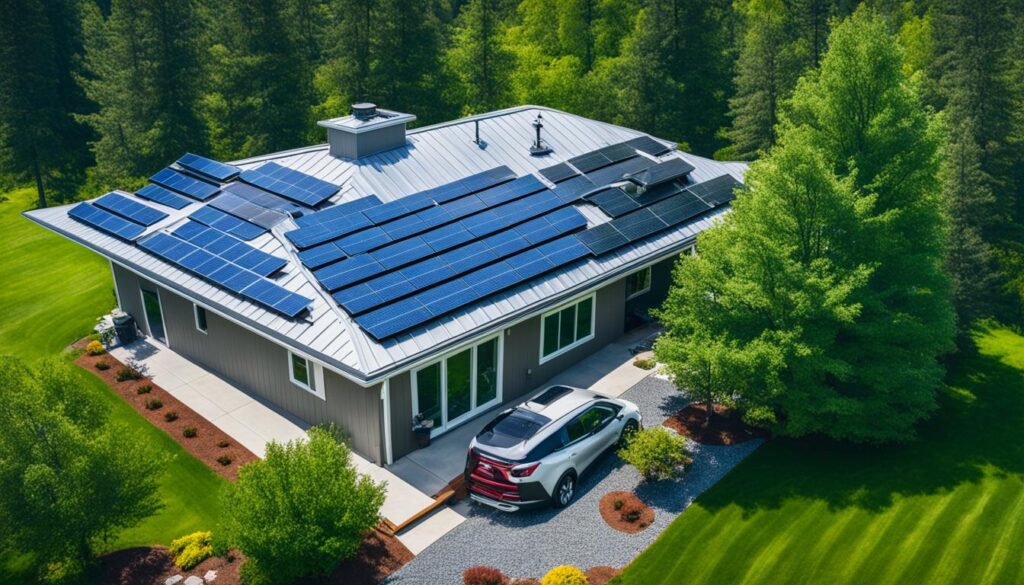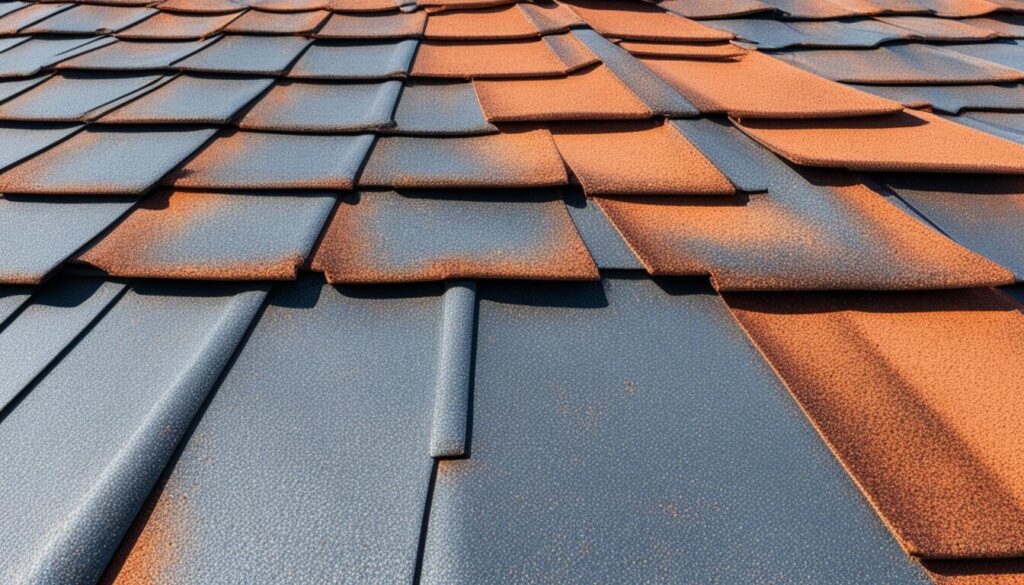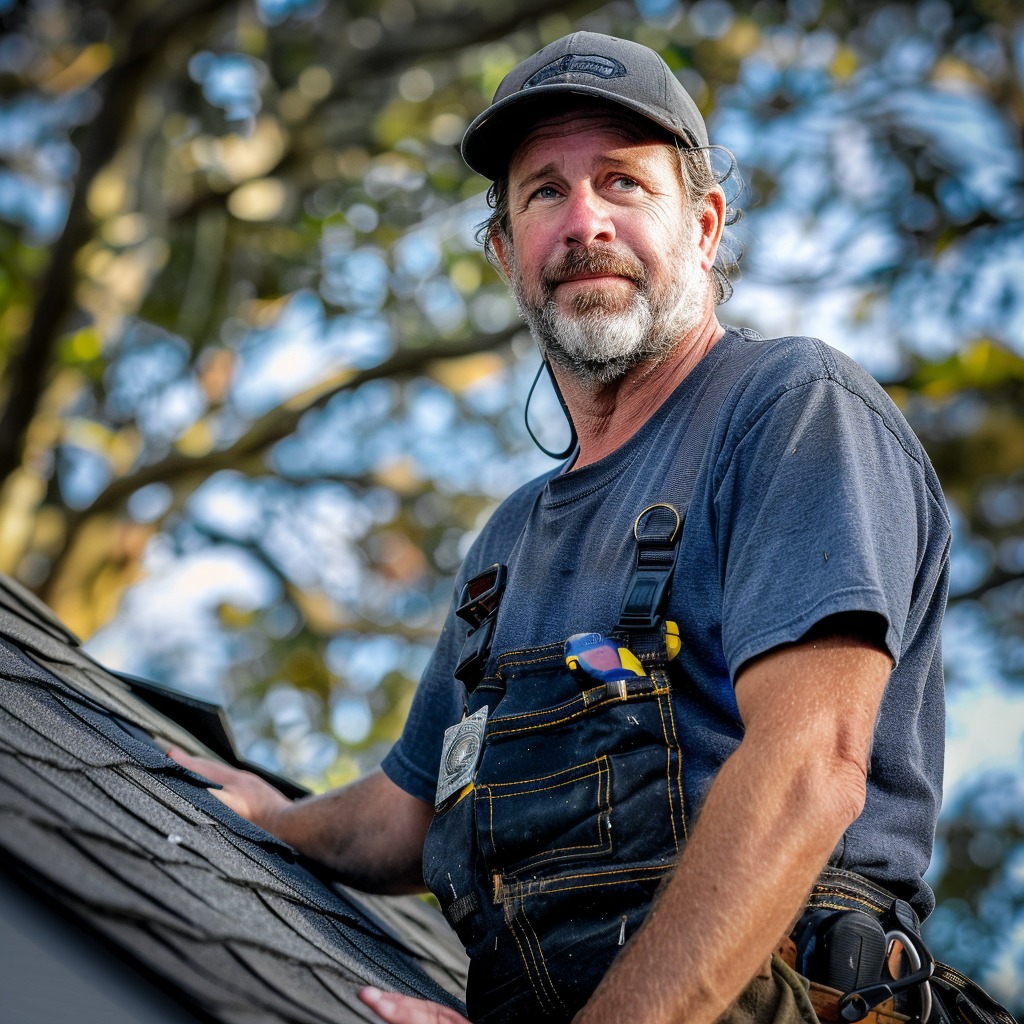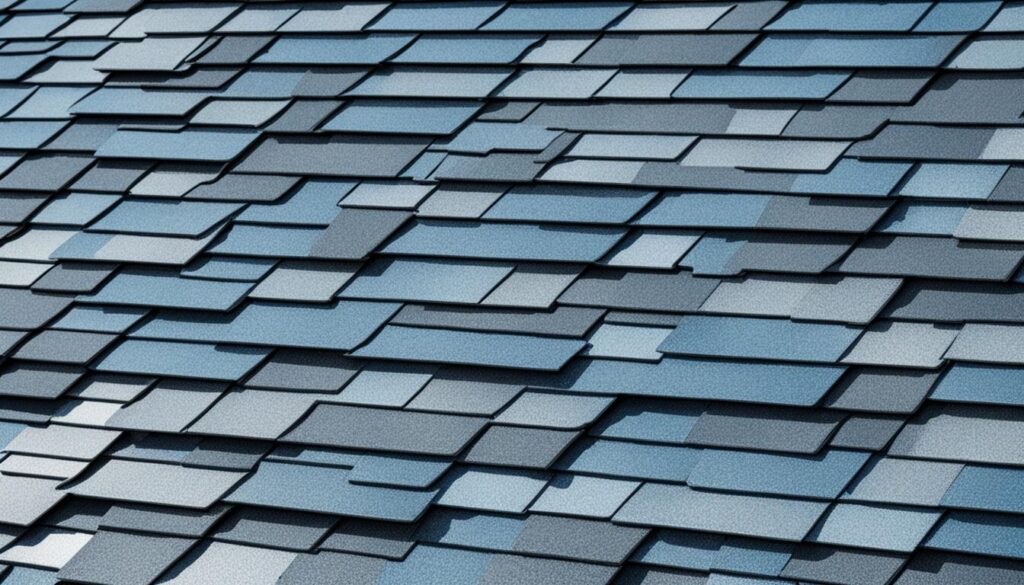Are you tired of constantly replacing your shingle roof? Is it time for a more durable and cost-effective solution? Have you ever considered installing a metal roof over shingles?
Many homeowners are unaware that installing a metal roof over shingles is a viable option. In fact, it offers numerous benefits and can be a smart investment for your home. But, before you make any decisions, it’s important to understand the ins and outs of this roofing solution.
In this article, we will explore the benefits of installing a metal roof over shingles, the considerations and potential problems involved, the different installation methods, and the cost factors to consider. By the end, you’ll have a comprehensive understanding of whether this option is right for you.
Key Takeaways:
- Installing a metal roof over shingles can be a cost-effective and durable roofing solution.
- Benefits include longevity, durability, energy efficiency, environmental friendliness, cost savings, low maintenance, and installation options.
- Check local building codes and ensure proper roof condition, slope, ventilation, and structural integrity before installation.
- There are three common installation methods: attaching metal roofing directly, using furring strips, or utilizing shingle recover systems.
- Potential problems may include moisture buildup, uneven surfaces, increased roof weight, old roof issues, building code violations, difficulty locating leaks, and warranty concerns.
- Factors affecting cost include material choice, labor costs, location-specific factors, and the decision to remove old shingles or install over them.
- Hiring a professional roofing contractor is recommended for proper installation and to ensure compliance with building codes.
Now that you know what to expect, let’s dive deeper into the benefits and considerations of installing a metal roof over shingles.
Can You Install a Metal Roof Over Shingles?
Thinking about installing a metal roof over shingles? You’re in luck! In most cases, it is possible to install a metal roof over existing shingles. However, there are a few considerations you should keep in mind throughout the process.
First and foremost, it’s crucial to check your local building codes. Building codes can vary by location, and it’s essential to ensure you are complying with the regulations in your area. Some jurisdictions may allow for re-roofing over one layer of shingles, while others may permit two layers. By checking the building codes, you can ensure you are following the correct guidelines for your project.
Before diving into the installation, there are a few additional considerations to take into account. It’s important to inspect the condition of your roof to identify any existing issues such as leaks or damage. Addressing these problems before installing the metal roof is essential to maintain its integrity.
Furthermore, proper roof slope and ventilation are crucial factors to consider. Ensure that your roof has the appropriate slope to facilitate proper drainage and prevent water from pooling. Adequate ventilation is also important to prevent moisture buildup, which can lead to mold and other issues.
Lastly, it’s essential to assess the structural integrity of your home. Installing a metal roof adds additional weight to your roof, and it’s important to make sure your home can support this extra load. Consider consulting a structural engineer to ensure your home’s structure is suitable for a metal roof installation.
By considering these factors and ensuring you are meeting the necessary requirements, you can confidently install a metal roof over shingles. Enjoy the benefits of a durable, energy-efficient, and long-lasting roofing solution!
Benefits of Metal Roof Over Shingles
Installing a metal roof over shingles offers several advantages. Let’s explore the benefits in detail:
Longevity
Metal roofs have a significantly longer lifespan compared to asphalt shingle roofs. While shingle roofs typically last 20 to 30 years, metal roofs can last 40 to 70 years or even more. This longevity ensures that you won’t have to worry about frequent roof replacements, saving you both time and money in the long run.
Durability
Metal roofs are highly durable and can withstand various weather conditions. They are resistant to cracking, warping, and corrosion, making them a reliable choice for homeowners. Whether it’s heavy snow, strong winds, or intense heat, a metal roof will hold up and continue to protect your home.
Energy Efficiency
Metal roofs are known for their energy-efficient properties. They have excellent heat-reflective capabilities, which can significantly reduce your cooling costs during hot summer months. The metal reflects solar energy instead of absorbing it, keeping your home cooler and reducing the strain on your air conditioning system.
Cost Savings
Although metal roofs may have a higher upfront cost compared to shingle roofs, they offer long-term cost savings. With its longevity and durability, you won’t need to spend money on frequent repairs or replacements. Additionally, metal roofs are low maintenance, requiring minimal upkeep and reducing ongoing expenses.
Environmental Friendliness
Metal roofs are an environmentally friendly option for roofing. They can be made from recycled materials, such as aluminum or steel, and are fully recyclable at the end of their lifespan. By choosing a metal roof, you contribute to reducing waste and promoting sustainability.
Installation Options
When installing a metal roof over shingles, you have various installation options to choose from. You can either attach the metal roofing panels directly through the shingles, use furring strips to create a flat surface, or opt for shingle recover systems. These installation options provide flexibility and adaptability to meet your specific roofing needs.
Overall, a metal roof over shingles offers numerous benefits, including longevity, durability, energy efficiency, cost savings, low maintenance, and installation options. It’s a smart investment that enhances the aesthetics and value of your home while providing long-term protection.
Image:

Considerations for Metal Roof Over Shingles
When planning to install a metal roof over shingles, there are several important considerations to keep in mind to ensure a successful and durable roofing solution. These considerations revolve around local building codes, roof condition, roof slope, ventilation, and structural integrity.
Local Building Codes
Before proceeding with the installation, it is crucial to check the local building codes in your area. Building codes vary by location, and it is essential to comply with the specific requirements and regulations set by your municipality. This ensures that the installation is up to standard and meets safety and construction guidelines.
Roof Condition
Prior to installing a metal roof over shingles, it is important to thoroughly inspect the existing roof condition. Look for any signs of leaks, damage, or weakened areas. Any issues with the current roof should be addressed and resolved before proceeding with the installation to avoid future problems.
Roof Slope
The roof slope plays a crucial role in ensuring proper drainage and preventing moisture buildup. It is important to assess the slope of the roof and ensure that it meets the recommended slope for the specific metal roofing system being installed. This promotes adequate water runoff and prevents the accumulation of stagnant water.
Ventilation
Proper ventilation is essential for maintaining the longevity and performance of the metal roof over shingles. It helps to regulate temperature, prevent moisture buildup, and reduce the risk of mold or mildew growth. Evaluate the existing ventilation system and make any necessary adjustments or improvements to ensure optimal airflow.
Structural Integrity
Lastly, it is crucial to assess the structural integrity of the home before installing a metal roof over shingles. Metal roofs are heavier than shingle roofs, and the existing structure must be capable of supporting the additional weight. Consult with a structural engineer or roofing professional to evaluate the load-bearing capacity of the roof and make any necessary reinforcements.
| Considerations for Metal Roof Over Shingles | |
|---|---|
| Local Building Codes | Check and comply with local building codes to ensure the installation meets safety and construction regulations. |
| Roof Condition | Thoroughly inspect the existing roof condition for leaks, damage, or weakened areas before installation. |
| Roof Slope | Assess the roof slope to ensure proper drainage and prevent moisture buildup. |
| Ventilation | Evaluate the existing ventilation system and make necessary adjustments to promote optimal airflow. |
| Structural Integrity | Assess the structural integrity of the home to ensure it can support the additional weight of the metal roof. |
Installation Methods for Metal Roof Over Shingles
When it comes to installing a metal roof over shingles, there are three common methods that you can consider. Each method has its own advantages and considerations, allowing you to choose the one that best suits your specific needs and circumstances. Let’s take a closer look at these installation methods:
1. Attaching Metal Roofing Directly
One way to install a metal roof over shingles is by attaching the metal roofing panels directly through the shingles and into the wood deck below. This method offers simplicity and requires fewer materials, making it a popular choice for many homeowners. By fastening the metal panels directly, you achieve a secure and stable installation.
2. Furring Strips
Another installation method involves the use of furring strips as a base for the metal roof. Furring strips are wooden strips that create a flat surface for the metal roof installation. By placing them over the shingles, you can overcome any imperfections or irregularities in the existing roof surface. This method provides better ventilation and insulation, improving the overall performance of your metal roof.
3. Shingle Recover Systems
The third method is to use shingle recover systems, which allow for metal roofing installation over existing shingles without a complete tear-off or separate framing system. This method saves time and labor costs associated with removing the old shingles. With a shingle recover system, the metal panels are installed directly onto the existing shingles, providing a seamless and efficient installation process.
Each installation method has its own unique benefits and considerations. It is important to consult with a professional roofing contractor to determine the best approach for your specific situation. They will consider factors such as the condition of your existing roof, local building codes, and your specific preferences to recommend the most suitable installation method.
Potential Problems with Metal Roof Over Shingles
While installing a metal roof over shingles offers numerous benefits, there are potential problems that homeowners should be aware of. These issues can arise during the installation process or later on, affecting the overall performance and longevity of the roofing system. Let’s explore some of the potential problems:
Moisture Buildup
One common issue when installing a metal roof over shingles is the potential for moisture buildup between the layers. This can happen if there are existing leaks or inadequate ventilation. Over time, trapped moisture can lead to mold growth, corrosion, and structural damage.
Uneven Surfaces
Uneven surfaces on the shingles can pose challenges during metal roof installation. If the old shingles have curled, cracked, or missing sections, it can create an uneven substrate. This can cause improper fastening of the metal panels, leading to leaks and compromised weather resistance.
Increased Roof Weight
When adding a metal roof over existing shingles, there is a significant increase in roof weight. While metal roofs are typically lightweight, the additional layer of shingles can put added stress on the structure. It’s crucial to ensure that the building can support the increased load to avoid structural issues.
Old Roof Issues
Installing a metal roof over shingles may not address underlying issues with the old roof. If there are existing problems such as damaged decking, rot, or weak spots, they can negatively impact the performance of the new metal roof. It’s essential to thoroughly inspect and address any pre-existing issues before installation.
Building Code Violations
Each jurisdiction has its own building codes and regulations regarding installing a metal roof over shingles. Failure to comply with these codes can lead to legal issues and potential safety hazards. It’s crucial to obtain the necessary permits and ensure that the installation meets all building code requirements.
Difficulty Locating Leaks
Finding and repairing leaks can be challenging when a metal roof is installed over shingles. The multiple layers can make it difficult to pinpoint the source of leaks, causing delays and frustration during repair attempts. Proper installation techniques and regular maintenance can help mitigate this issue.
Warranty Concerns
Installing a metal roof over shingles may affect the warranty coverage provided by the roofing manufacturer. Some warranties may require a complete tear-off of the old roof before installing the new metal roofing system. It’s essential to review the warranty terms and consult with the roofing manufacturer to ensure compliance.
| Potential Problems with Metal Roof Over Shingles |
|---|
| Moisture Buildup |
| Uneven Surfaces |
| Increased Roof Weight |
| Old Roof Issues |
| Building Code Violations |
| Difficulty Locating Leaks |
| Warranty Concerns |
Addressing these potential problems is crucial to ensure a successful metal roof installation over shingles. Engaging professional contractors with expertise in metal roof installations is highly recommended. They can assess the existing roof condition, provide proper recommendations, and ensure code compliance, leading to a reliable and long-lasting roofing solution.

Cost Considerations for Metal Roof Over Shingles
When considering the installation of a metal roof over shingles, it’s essential to take into account various factors that can impact the overall cost of the project. These factors include:
- Materials: The type of metal roofing material chosen can significantly affect the cost. Steel, aluminum, copper, and zinc are commonly used materials, each with its own price point.
- Labor: The cost of labor will vary depending on the complexity of the installation, the size of the roof, and the experience of the roofing contractor.
- Location-specific factors: Building codes and climate conditions can influence the cost. Certain areas may have specific requirements that need to be met for the metal roof installation. Additionally, regions with harsh weather conditions may require additional reinforcement or insulation, resulting in higher costs.
- Old shingles removal vs. installing over them: One cost consideration is whether to remove the old shingles or install the metal roof over them. Removing the old shingles can incur additional labor and disposal fees, while installing over them can save time and money.
- DIY installation: Opting for a DIY installation may seem like a cost-saving measure, but it’s important to consider the potential risks. Improper installation can lead to future complications that may end up costing more to fix. Additionally, attempting a DIY installation can void warranties provided by manufacturers.
It’s crucial to carefully weigh these cost factors and consult with professionals to ensure an accurate estimate and a successful metal roof installation.
Conclusion
Installing a metal roof over shingles can provide homeowners with a cost-effective and durable roofing solution. By opting for this method, homeowners can enjoy the benefits of increased longevity, enhanced durability, improved energy efficiency, and potential cost savings in the long run.
However, before embarking on this journey, it is crucial to consider and adhere to local building codes to ensure compliance. Additionally, conducting a thorough inspection of the roof condition and addressing any existing issues is essential. Proper roof slope and ventilation must be ensured to avoid moisture buildup. Assessing the structural integrity of the home is also important to ensure it can support the added weight of the metal roof.
Given these considerations, it is highly recommended to hire a professional roofing contractor for the proper installation of a metal roof over shingles. Their expertise and experience will ensure a seamless installation process. Moreover, it is crucial to carefully evaluate the cost factors involved and weigh the pros and cons of this roofing solution, enabling homeowners to make an informed decision about their roofing needs.

Meet William Adams, a seasoned roofing expert with over 30 years of hands-on experience in the industry. Having worked tirelessly under the scorching sun and through the fiercest storms, William brings a wealth of knowledge and expertise to the table. Hailing from the heart of the USA, he’s witnessed the evolution of roofing practices firsthand, mastering every aspect along the way. Now retired from the field, William spends his days cherishing time with his loved ones while sharing his invaluable insights through this platform. With William at the helm, you can trust that every tip, advice, and recommendation provided is backed by years of real-world experience and unwavering dedication to quality craftsmanship. Join us as we journey through the world of roofing, guided by the wisdom and passion of a true industry veteran.

